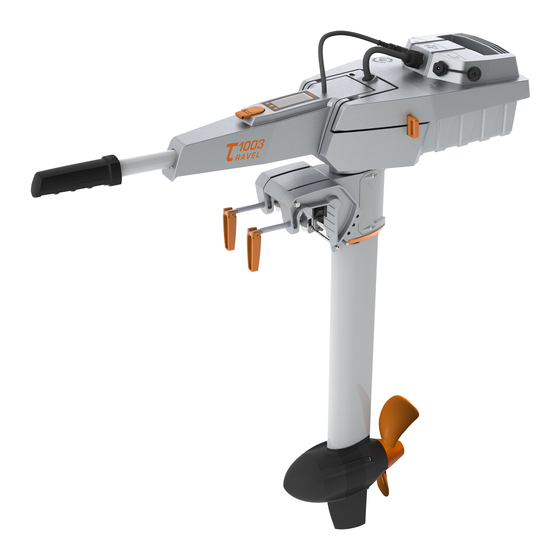
- Torqeedo Manuals
- Outboard Motor
- Travel 503 L
- Operating manual

Torqeedo Travel 503 S Operating Manual
- Operating manual (31 pages)
- Owner's manual (30 pages)
- Manual (32 pages)
- page of 60 Go / 60
Table of Contents
- Troubleshooting
2 Important Safety and Operating Information
3 introduction, 4 information required by law.
- Identification and Technical Data
- Technical Data
- Conformity Declaration
5 Equipment and Operating Elements
- Delivery Scope
- Plan of Operating Elements
6 Starting up
7 operation.
- Normal Operation
- Multifunctional Display with Beep
- Tilting the Motor and Fixing the Steering
- General Information
- Charging the Batteries from the Mains
- Charging the Batteries from the On-Board Batteries
- Charging the Batteries Using Solar Energy
- Power Supply to a Device Via USB Supply Connection
- Unusual Functions/Emergency Situations
- Error Messages/Trouble Shooting
8 Dismantling
9 storage and care instructions.
- Corrosion Protection, Care, Maintenance
- Caring for the Battery
- Changing the Propeller
10 Warranty Terms
- Extent of Warranty
- Warranty Process
11 Accessories
12 decommissioning the product / disposal, 2 wichtige sicherheits- und handhabungshinweise, 3 einleitung, 4 gesetzliche vorgeschriebene angaben.
- Identifizierung und Technische Daten
- Technische Daten
- Konformitätserklärung
5 Ausstattung und Bedienelemente
- Lieferumfang
- Übersicht Bedienelemente und Komponenten
6 Inbetriebnahme
7 bedienung.
- Fahrbetrieb
- Multifunktionsanzeige mit Signalton
- Kippen des Motors und Fixierung der Lenkung
- Allgemeine Hinweise Akku
- Laden des Akkus mit Netzteil
- Laden des Akkus vom Bordnetz
- Solar-Laden des Akkus
- Versorgung eines Gerätes über den USB Versorgungsanschluss
- Außergewöhnliche Funktionen/Notsituationen
- Fehlermeldungen/Fehlersuche
8 Demontage
9 hinweise zur lagerung und pflege.
- Allgemeine Pflegehinweise, Wartung und Korrosionsschutz
- Wechseln des Propellers
10 Garantiebedingungen
- Garantieumfang
- Garantieprozess
13 Torqeedo Service Centers
12 außerbetriebnahme des produkts / entsorgung, 13 torqeedo service center.
Advertisement
Available languages
- ENGLISH, page 1
- DEUTSCH, seite 31
Quick Links
Related manuals for torqeedo travel 503 s.

Summary of Contents for Torqeedo Travel 503 S
- Page 1 Travel 503 S / L Travel 1003 S / L Operating manual (English) Bedienungsanleitung (Deutsch)
Page 3: Table Of Contents
Page 4: important safety and operating information.
- Page 5 This symbol warns about the risk of damage to or by your outboard motor. There follows a selection of the most important instructions for handling Torqeedo Travel motors. Apart from these instructions, please observe the complete operating manual to prevent damage to or by your motor.
Page 6: Introduction
Page 7: technical data, page 8: conformity declaration, page 9: equipment and operating elements, page 10: starting up.
- Page 11 Mount gently No force required When you are using the battery for the first time or after several months of storage, charge it up to 100% to calibrate the battery me- ter (charging the battery up to 99% is not sufficient for the calibrati- on).
Page 12: Operation
- Page 13 Use the “setup” button to set the units for the display: First you can select the units in which the remaining range is displayed. Press the “cal“ button to switch between information in kilometers, statutory miles, nautical miles, and hours. You confirm your selection by pressing “setup” again. You then enter the speed indicator setting. You can choose between kilometers per hour, miles per hour, and knots. The selection is made again by pressing the “cal“ button. You confirm your selection by pressing “setup” again. Finally you select the battery information displayed. You can chose between charge status in percent and voltage. Select the information to be displayed by pressing the “cal” but- ton and confirm your choice by pressing the “setup”...
Page 14: Multifunctional Display With Beep
Page 15: operating the batteries, page 16: charging the batteries from the mains, page 17: charging the batteries from the on-board batteries, page 18: charging the batteries using solar energy, page 19: unusual functions/emergency situations, page 20: error messages/trouble shooting, page 21: dismantling, page 22: storage and care instructions, page 23: changing the propeller, page 24: warranty terms, page 25: warranty process, page 26: accessories, page 27: decommissioning the product / disposal.
- Page 30 Service Center directly, not to Service Partners) Thank you very much for your cooperation, the Torqeedo Service Europe & international: [email protected] T +49 - 8153 - 92 15 - 126 F +49 - 8153 - 92 15 - 329 A list of Certified Service Centres can be found under www.torqeedo.com, Service Center North America : [email protected] T +1-815-444-8806 F +1-815-444-8807 A list of Certified Service Centers can be found under www.torqeedo.com, Service Center...
- Page 31 Straße Land Telefon PLZ, Ort E-Mail Mobiltelefon falls vorhanden: Kunden-Nr. reklamationsdaten Genaue Produktbezeichnung Seriennummer Kaufdatum Betriebsstunden (ca.) Händler, bei dem das Produkt gekauft wurde Anschrift des Händlers (PLZ, Ort, Land) Ausführliche Problembeschreibung (inklusive Fehlermeldung, in welcher Situation trat der Fehler auf etc.) Vorgangsnummer (bei Einsendung an das Torqeedo Service Center in Gilching zwingend erforderlich, die Sendung kann ansonsten nicht angenommen werden) Vielen Dank für Ihre Kooperation, Ihr Torqeedo Service Torqeedo Service Gilching: [email protected] T +49 - 8153 - 92 15 - 126 F +49 - 8153 - 92 15 - 329 Deutschland / Europa: Sie finden den nächsten Service-Standort auf www.torqeedo.com unter Service Center...
- Page 35 7.2 Multifunktionsanzeige mit Signalton 7.3 Kippen des Motors und Fixierung der Lenkung 7.4 Bedienung des Akkus 7.4.1 Allgemeine Hinweise Akku 7.4.2 Laden des Akkus mit Netzteil 7.4.3 Laden des Akkus vom Bordnetz 7.4.4 Solar-Laden des Akkus 7.4.5 Versorgung eines Gerätes über den USB Versorgungsanschluss 7.5 Außergewöhnliche Funktionen/Notsituationen 7.6 Fehlermeldungen/Fehlersuche 8. Demontage 9. Hinweise zur Lagerung und Pflege 9.1 Allgemeine Pflegehinweise, Wartung und Korrosionsschutz 9.2 Akkupflege 9.3 Wechseln des Propellers 10. Garantiebedingungen 10.1 Garantieumfang 10.2 Garantieprozess 11. Zubehör 12. Außerbetriebnahme des Produkts / Entsorgung 13. Torqeedo Service Center...

Page 36: Wichtige Sicherheits- Und Handhabungshinweise
- Page 37 Regulierung nicht betroffen. Achten Sie bei privatem Transport darauf, dass das Akkugehäuse nicht beschädigt wird. • Beachten Sie neben diesen ausgewählten Hinweisen die gesamte Gebrauchsanweisung. ACHTUNG Dieses Symbol warnt vor Beschädigungsgefahren für oder durch Ihren Außenbordmotor. Nachfolgend finden Sie eine Auswahl der wichtigsten Hinweise zur Handhabung von Torqeedo Travel Motoren. Bitte beachten Sie neben diesen Hinweisen die gesamte Bedie- nungsanleitung, um Schäden an Ihrem Motor zu verhindern. • Betreiben Sie den Motor nur, während sich der Propeller unter Wasser befindet. Bei längerem Betrieb außerhalb des Wassers nehmen die Wellendichtringe Schaden, die den Motor an der Getriebewelle abdichten, und es besteht die Gefahr der Überhitzung des Motors. • Die Travel 503/1003 Modelle sind nach Schutzart IP67 gegen Schmutz- und Wasserein- tritt geschützt (1 Stunde unter Wasser bei einer Eintauchtiefe von 1 Meter).
Page 38: Einleitung
Page 39: technische daten, page 40: konformitätserklärung, page 41: ausstattung und bedienelemente, page 42: inbetriebnahme.
- Page 43 Montage ohne Kraftaufwand! 1. einfach in Halterung gleiten lassen 2. langsam in eine waagerechte Position bringen • Vor der ersten Benutzung oder nach mehrmonatiger Lagerung sollte die Batterie zu 100% vollgeladen werden, um die Batterie Ladestandanzeige zu kalibrieren (99% Ladung ist für die Kalibrierung nicht ausreichend). • Achten Sie darauf, dass die Kabel nicht gequetscht, eingeklemmt oder beschädigt werden. • Achten Sie darauf, dass die Überwurfmuttern der Stecker gerade aufge- setzt werden und das Gewinde beim Festziehen nicht beschädigt wird.
Page 44: Bedienung
- Page 45 Mit der „setup“-Taste haben Sie die Möglichkeit, die Einheiten der Anzeige einzustellen. Durch Drücken der „setup“-Taste gelangen Sie in das Menü. Zunächst können Sie die Einheiten auswählen, in denen die verbleibende Reichweite angezeigt wird. Durch Drük- ken der „cal“-Taste wählen Sie zwischen Angaben in Kilometern, Meilen, Seemeilen und Stunden. Durch nochmaliges Drücken der „setup“-Taste bestätigen Sie Ihre Auswahl. Sie gelangen dann in die Einstellung der Geschwindigkeitsanzeige. Hier können Sie zwischen Stundenkilometern, Meilen pro Stunde und Knoten wählen. Die Auswahl erfolgt wiederum durch Drücken der “cal“ Taste. Durch erneutes Drücken der „setup“-Taste be- stätigen Sie Ihre Auswahl und gehen zum nächsten Anzeigefeld. Abschließend wird die Anzeige des Batteriestatus gewählt. Sie haben die Auswahl zwischen „Akku-Ladestand in Prozent“ sowie „Spannung in Volt“. Die Auswahl der ge- wünschten Anzeige erfolgt wieder mit Hilfe der „cal“-Taste. Durch Drücken von „setup“ bestätigen Sie Ihre Auswahl und verlassen das „setup“ Menü. Die Aufschrift „cal“ auf der mittleren Taste steht für „calibration“ oder Kalibrierung. Im Fall einer entsprechenden Fehlermeldung im Display können Sie mit Hilfe dieser Taste die Pinne neu kalibrieren. Details hierzu finden Sie im Kapitel „Fehlermeldungen/Fehlersuche“. Anzeige-Beispiel im Normalbetrieb: Batterie-Ladestand in Prozent Verbleibende Reichweite bei aktueller Geschwindigkeit Geschwindigkeit über Grund Aktueller Leistungsverbrauch in Watt Andere Anzeigen: Drive slowly: Erscheint, wenn die Akkukapazität <30% ist.
Page 46: Kippen Des Motors Und Fixierung Der Lenkung
Page 47: bedienung des akkus, page 48: laden des akkus mit netzteil, page 49: laden des akkus vom bordnetz, page 50: solar-laden des akkus, page 51: außergewöhnliche funktionen/notsituationen, page 52: fehlermeldungen/fehlersuche, page 53: demontage, page 54: hinweise zur lagerung und pflege, page 55: wechseln des propellers, page 56: torqeedo service centers, page 57: garantieprozess, page 58: zubehör, page 59: außerbetriebnahme des produkts / entsorgung, page 60: torqeedo service center, this manual is also suitable for:, rename the bookmark, delete bookmark, delete from my manuals, upload manual.
Product Reviews
Torqeedo’s Travel 1003
Clean, quiet outboard power
From Issue September 2015
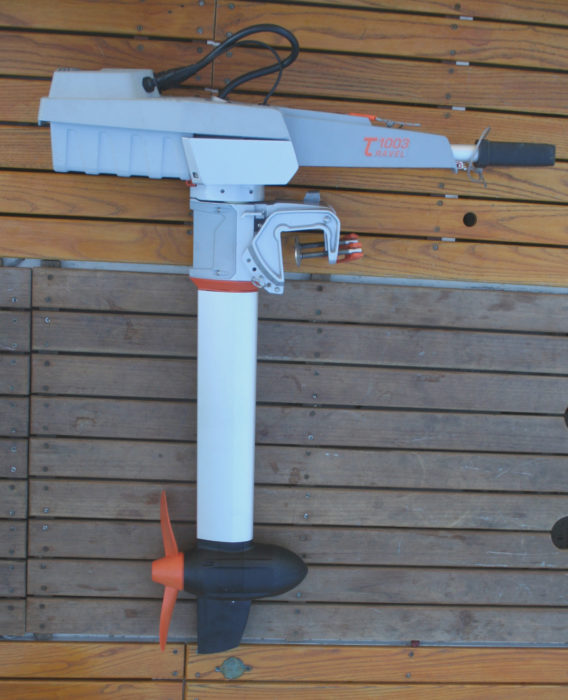
Torqeedo’s outboards with ratings up to an equivalent of 8 hp are designed without anti-ventilation plates. The foil-sectioned shafts on all but the smallest outboard aid in keeping surface air from getting to the prop.
F or decades I resisted boating under power and took pride in getting where I wanted to go under my own steam or under sail. That changed when I had kids: they were too young to help with rowing, the summer winds are usually too light for getting anywhere by sailing, and the joy of hanging out with them meant more to me than manning the oars. I built a Caledonia yawl with them in mind and installed a motor well. I bought a small 2.5-hp Yamaha outboard—a four-stroke to avoid leaving behind a cloud of stinky blue smoke typical of two-stroke outboards—but it still had an environmental impact in both the fuel it consumed and the peace it disturbed. For the past 11 years, Torqeedo has worked to eliminate both with their electric motors. In 2010 I tried the smallest motor they produce, the Ultralight, on a kayak. The equivalent of a 1-hp motor, the Ultralight would drive the kayak at an impressive 4 ¼ knots and an exciting 5 ½ knots after I added a foil-shaped fairing to the tubular shaft.
The two Travel motors are the smallest of the Torqeedo outboards. The Travel 503 is rated as the equivalent of a 1.5-hp gas motor; the Travel 1003, the equivalent of a 3-hp. I tried the Travel 1003S (S for short shaft) on three different boats: the Caledonia yawl, a Whitehall, and an Escargot canal boat. Torqeedo lists the shaft length for the Travel 1003S at 62.5 cm (24 5/8″), a measurement from the bearing surface of the mounting bracket to the center of the prop. On gas outboards the shaft length is commonly measured to the anti-ventilation plate, not the propeller axis; the Travel 1003 has no anti-ventilation plate, but I measured 46.5 cm (18 ¼″) to where one would be. That’s roughly the maximum span between the bottom of the hull and the site for the mounting bracket. The shaft length for the Travel 1003L is listed as 75cm/29.5″.)
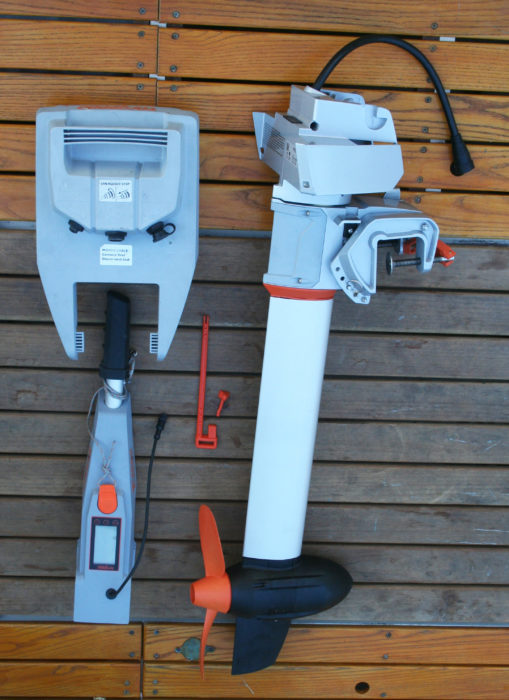
Disassembling the motor makes it much easier to stow out of the way when it’s not needed. The long pin locks the battery pack in place.
The Travel 1003 weighs 30 lbs, 7 lbs less than my Yamaha, and it separates into three pieces—the tiller and its computer just shy of 2 lbs, the battery at 12 lbs, and the lower unit about 16 lbs—making it a whole lot easier to move around, mount, and stow.
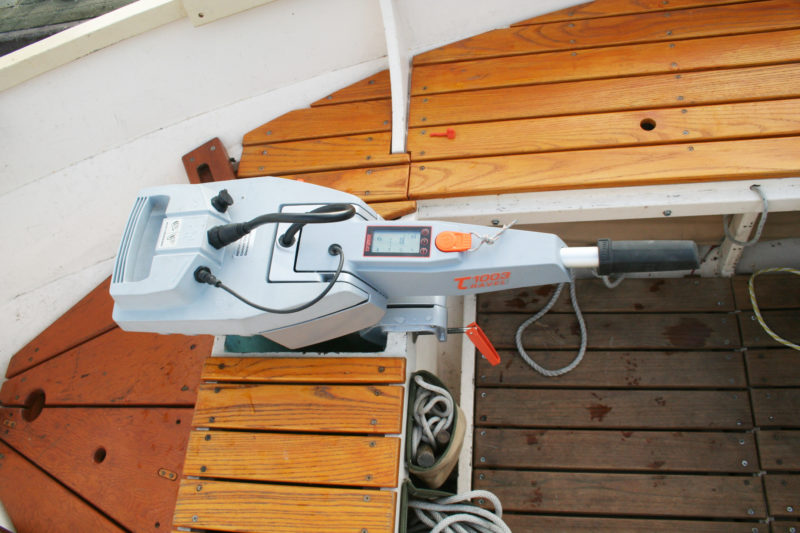
Set in the motor well of a Caledonia yawl, the Travel 1003 S reached a maximum speed of 5 knots. The orange pin on the bench locks the shaft when the boat’s rudder is used for steering. The orange tab on the tiller is a magnetic kill switch.
I used the Travel 1003 first on my Caledonia yawl, a 19′ 6″ x 6′ 2″ double-ender. With the motor at full throttle, the yawl peaked at 5.0 knots. My Yamaha logged a top speed of 5.8 knots. (I have an electric trolling motor rated at 40 lbs of thrust, but it falls so far short of the Travel 1003 that I don’t bother including it in these trials.) A built-in computer with GPS shows the percentage of battery charge and the distance it will take you at the speed indicated. At full speed a full charge had a cruising range of 2.4 nm. At 4 knots that range increased to 6.3 nm, at 3 knots 9.5nm, and at 2 knots 15.6 nm. The speeds and ranges I recorded were consistent with Torqeedo’s data for the Travel 1003 .
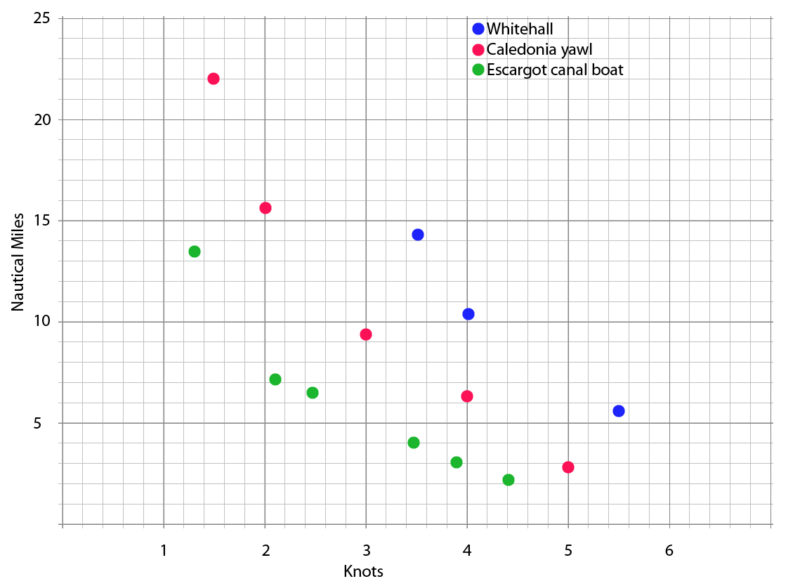
Ranges predicted by the Travel 1003 for a full battery charge with three boats at various speeds
There is a slight lag in the response to the throttle, and the motor will ramp up to the selected speed rather than apply full power immediately. That keeps the boat from lurching about, and, I imagine, prolongs the life of the motor and the boat. Even with the lag and ramp-up, I was impressed with how quickly the Travel 1003 could bring the yawl from 5 knots at full speed ahead to a dead stop: just 3 seconds and less than two boat-lengths.
The Travel 1003 operates in reverse, and a latch keeps the shaft locked down to prevent the prop from climbing. The yawl made 3.5 knots with the Travel 1003 in reverse at full throttle. (The Yamaha does not have reverse but rotates through 360 degrees, as does the Travel 1003.) Releasing the latch allows the motor to kick up over obstructions while moving forward and to be raised to reduce the drag while rowing or sailing. A removable pin will lock the Travel 1003 facing straight ahead for steering with a boat’s rudder.
The Travel 1003 is quiet but not completely silent. It has a whine that rises in pitch and volume as the throttle gets cranked up, but even at its loudest it is neither an impediment to a conversation nor anywhere near as loud as my gas outboard. It doesn’t vibrate either, so there’s no rattling anywhere on the boat. Its relatively quiet operation at low-to-moderate speeds is great for dinner cruises. I’m used to gauging speed by the racket my gas motor makes when moving along at a good clip, but even at full throttle, the sound the Travel 1003 makes belies how fast the boat is moving; it’s more like sailing than motoring.
On my 14′ lapstrake Whitehall the Travel 1003 peaked at 5.5 knots. (I didn’t—and wouldn’t—try to mount the heavier Yamaha on the transom—there’s little buoyancy in the stern.) I also did trials with my son’s 19′ 6″ x 6′ Escargot canal boat , weighing over a half ton with gear and two of us aboard. It brought the canal boat up to 4.4 knots, just slightly slower than the Yamaha at 4.7 knots.
Torqueedo claims on its website that the Travel 1003 “can do everything a 3-hp petrol outboard can, plus it’s environmentally friendlier, quieter, lighter, and more convenient.” The latter half of that is certainly true, but I’d suggest the former isn’t a good comparison to make. According to the owner’s manual, my Yamaha has a maximum output of 2.5 horsepower or 1.8 kW at 5,500 rpm, while the Travel 1003 display reads 1,000 watts (1.0 kW) at full throttle with maximum propeller speed listed by Torqeedo at 1,200 rpm. Going by the numbers gets murky. The Yamaha rating is for propeller-shaft horsepower, and the Torqeedo rating is for input power with propulsive power at 480 watts; static thrust is listed as 68 lbs, but that’s not calculated the same way as it is for trolling motors. Torqeedo offers some clarification on the terms and their equivalence with gas outboards, but my sea trials for top speed didn’t bear that out for the Travel 1003, even up against a 2.5-hp instead of a 3-hp gas outboard.
I haven’t made precise mileage calculations for my gas outboard, but one measurement I made on Google Earth for a passage on a full tank of gas (0.24 gallon) was 6 miles, running at about two-thirds throttle. That’s 25 miles per gallon. At a comparable speed the Travel 1003 will cover about the same distance. To extend the range of my gas outboard, I’ll carry two 2.5-gallon gas cans for a range of 125 miles. For the Travel 1003, an extra battery, at $650, brings the range to 16 miles. For charging away from home, Torqeedo offers a 50-watt solar charger for the Travel 1003, and it is possible to recharge its battery from an in-board 12-volt system. In my experience recharging was an overnight process, only slightly more than the 14 hours listed by Torqeedo; the latest models have cut that time in half. While I don’t have to think much about my range with my gas outboard, the Travel 1003 would require some thoughtful planning to achieve the same range for an extended cruise. If your outings with the Travel 1003 aren’t pushing the limits of its range, you can use the energy for other purposes: its battery has a port you can use to charge electronic devices.
Christopher Cunningham is the editor of Small Boats Monthly.
Torqeedo distributes its products through a network of dealers and offers the Travel 1003 for $1,999 with a two-year warrantee.
Thanks to reader Elliot Arons for suggesting this review.
A Cautionary Tale
When I tested the Travel 1003 on my Whitehall, I put thin plywood pads on the varnished transom to protect it from the motor’s mounting bracket and turned the screws down as tight as I could, knowing they wouldn’t leave their mark on the mahogany. The Whitehall isn’t meant to carry an outboard, let alone maintain trim with the weight of a motor and its operator well aft, so I sat as far forward as I could and still keep a hand on the motor’s tiller. I made a few runs, back and forth in a protected canal, some at full speed. On the last run, while at full power, the tiller slipped suddenly from between my fingers and the motor turned 90 degrees, pushing parallel to the transom. It then twisted almost to horizontal and then slipped off the transom. I lunged for it as it went overboard and got a hand on the tiller. The magnetic kill switch disengaged and the prop stopped turning. I thought I had averted disaster, but as the boat carried forward, the angle between the tiller and the motor opened up and they parted, just as they’re meant to do if you’re disassembling the pieces for transport or storage. The cable from the tiller didn’t have a connection strong enough to hold the battery and lower unit, and down they went. I was left holding the tiller, a bit stunned.
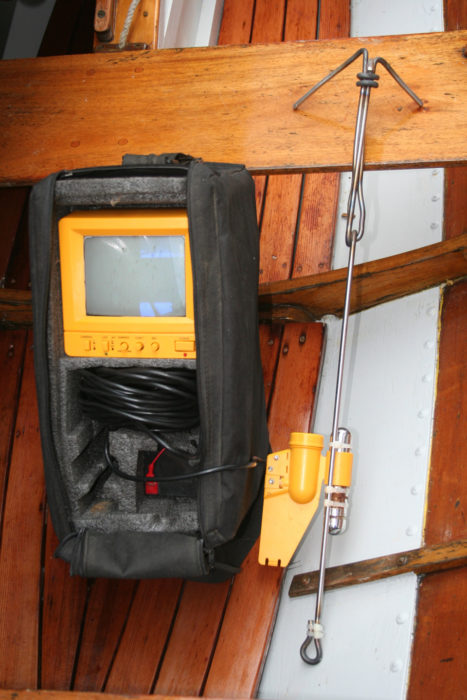
To recover the motor I needed to find it first, then snag it. The underwater video system and a hastily made grappling hook did the job.
I went home and made a grappling hook out of steel rod and connected it to my Harbor Freight underwater video camera. I was feeling hopeful about recovering the motor—it had gone down in a narrow stretch of water, and I had a pretty good idea of where it would have come to rest. Unfortunately, the water in the area was about 25′ deep and the light on the bottom was dim, so the video camera could show only a narrow swath of the sandy bottom. The next day I tried again, but it was too difficult to manage the boat and control the depth of the camera at the same time. I returned with my son Nate, and we were about to give up when he spotted the motor. It went in and out of the camera’s view, but after 20 minutes he got the hook on the power cable and brought the motor and battery up.
The Travel 1003 has an IP67 rating and is waterproof for 30 minutes at 1 meter, but not for two days at 25′. The red indicator light on the battery case blinked on a few times, and that was its last sign of life. I opened the case to get the water out of it and the damage to the batteries and the circuit board was evident.
I can’t fault the Travel 1003. I’m not sure what caused the sudden turn, but with the motor running at full power I should have had a firm grip on the tiller. The Travel 1003 can rotate 360 degrees and can be oriented parallel to the transom. My Yamaha is the same way and has, on two occasions, twisted its bracket a bit out of position when turned 90 degrees and gunned for tight maneuvering. Larger outboards may have stops to limit their steering range and lessen the chances of prying themselves off a transom. The plywood pads I used to protect my Whitehall’s transom may have lessened the Travel 1003’s grip, but if my calculation for the torque created—140 ft-lbs—is correct, it may have dislodged itself even without the pads.
Three precautions come to mind for small outboards that can rotate to 90 degrees on either side. A solidly anchored cleat along the edge of the transom where the motor is attached would serve as a stop for the clamps on the inboard side. Some commercially made pads for the inside face of the transom have a lip at the top meant to keep a loosened clamp from slipping off. (They require more time to get the motor in place; a couple of slots cut off-center alleviate that problem.) Secondly, a safety cable or chain can tether the motor to the boat. My Yamaha has a hole in the mounting bracket meant for a cable and includes a recommendation in the instruction manual to use it. The Travel 1003 has holes in the clamp screw handles that can serve as safety-cable attachment points; a note about using them as such would be a worthy addition to its user manual. Finally, hang on to the tiller.— CC
Epilogue (October 2, 2015)
While it was clear to me that an outboard capable of rotating through 360° has the potential to turn to 90°—parallel to the transom—and wrench itself out of position or tear itself off entirely, I didn’t understand what had caused the motor to turn in the first place. I found a likely explanation in the September/October issue of WoodenBoat magazine. That issue’s “Getting Started in Boats” feature is “A Small Outboard Motor Primer” by Jan Adkins. Jan describes “The Death Spiral,” a common accident in which the operator of an outboard skiff is thrown overboard by a sudden turn and often severely injured when the boat circles around. Here’s the cause of the spiral: “For any reason (inattention, slippery hands, a reflex to reach for something) the helmsperson’s steering hand leaves the outboard tiller/handle. Unequal resistance between the deep propeller blade and the shallow propeller blade exerts torque that twists the outboard to port. The small boat turns violently to starboard….”
In my case, I had a loose grip on the tiller and the motor twisted itself off the transom rather than cause a sharp turn to starboard. Because the boat hadn’t turned violently and I had been looking over the bow at the time, I don’t have a clear memory of which way the motor had turned (and I had revarnished the transom of my Whitehall) but the slight scars that remained indicated that the motor had indeed twisted to port. (The Travel 1003’s propeller has a right-hand rotation—clockwise when viewed from astern—typical of outboards and would twist to port. A left-hand prop would cause a boat to turn to port.)
My Yamaha has a screw that increases the friction in the mount to lock the motor in position if I’m using a rudder to steer. If I’m steering with the motor I maintain a little friction so I can steer well but don’t have to “micromanage” the tiller. The Travel 1003 uses a pin to lock the motor for using a rudder to steer and without the pin the motor can rotate freely. Even though the Yamaha can be adjusted for turning friction, I’ll be much more careful with both motors when using them to steer.— CC
Share this article
Join The Conversation
We welcome your comments about this article. If you’d like to include a photo or a video with your comment, please email the file or link.
Comments (10)
I have had Torqeedo Travel 1003 for several years. It has a strong battery and will push my Norseboat 17.5 for about 10 miles at 3.0 knots. As you say, it is not a good choice for extended multi-day trips where recharging may be difficult, but for a day trip or overnight it’s great.
Aside from the advantages you mention, there is no winterizing, spark plugs to foul, or fuel to spill. Best of all it starts with a twist of the throttle. I feel confident sending my kids or friends out without worrying about their ability to get a gas motor running.
The only drawback, as you point out, is the range, which I bet most of us never exceed anyway. The advantages are far more persuasive to me. If everyone was already using Torqeedos and the gas outboard was introduced as an alternative, I bet very few people would by one.
We have a 1003 that we use on our 28′ Stuart Knockabout which displaces 4,000 lbs. We have a removable side bracket made of very heavy stainless. We had 4-hp Yamaha 4-stroke on it for years and you you could go straight to full throttle. First time we tried that with the 1003, the incredible torque cracked the bracket! After we had it rewelded, we now accelerate slowly and never go to full throttle until the boat has some way on her. Full throttle is just shy of 5 knots and we usually run at 3 if the wind dies. Great motor! I only wish the tiller display was easier to read without glasses!
It should be noted that, unlike a gas motor, the Torqeedo must be removed when sailing. According to the manufacturer, it can not be freewheeled without damage to the motor. This is a pain, especially when one wants to go just a short distance before switching to sail. The motor must be taken off and stowed before sailing. I never worry about drag on my Caledonia, so I would rather leave the motor in the well, but it’s a no-go.

Question: Can the Torqeedo tilt up out of water if mounted on a transom?
Yes, the Torqeedo Travel can be tilted up out of the water just like any small outboard motor, so you can raise it for sailing, rowing, or coming ashore without having to remove it from the transom.

As a Torqeedo dealer and user on the Mississippi Gulf Coast, let me offer a clarification about the Travel 1003’s horsepower. The motor has a power consumption of 1000 watts at top speed, which is equal only to about 1 1/3 hp. While this keeps power consumption low, it also keeps the motor under 2 hp, which is useful for boats like the SolarSkiff that are designed following the US Coast Guard standards for watercraft with engines under 2 hp. However, Torqeedo claims a propulsive force equivalent to that of a 3 to 4 hp gas engine: its electric motor is more efficient at converting its 1000 watt input power into propulsive output power, hence the 3-4 hp “equivalency.” My wife and I had a chance to put this power claim to the test this summer. We crossed the Bay of St. Louis in a two-person SolarSkiff for a group picnic at some friends’ home across the Bay. Going over in the late morning, the winds were light. Coming back, however, the afternoon seabreeze predictably began to fill in and it wasn’t long before we were motoring back against 12-knot winds, gusting to 15, with whitecaps everywhere. The Torqeedo Travel 1003 had the power to keep us moving against the wind and waves with no problem: we can’t do that with a 55 lb-thrust trolling motor! While I can honestly say that 12-mph winds are about the top that I would plan to be out on the water in a small craft with a Torqeedo, it both had the power and the range we needed that day for the 6-1/2 mile round trip. I did take my Torqeedo battery charger in my dry bag, though, and plugged the battery in while we enjoyed lunch with our friends, just to make sure we had sufficient power for the return home.
The most I have run my battery down is to 20% of its maximum capacity, with the motor conveniently and automatically beeping reminder warnings when it hits 30%, 20%, and 10% capacity. With the new lithium-ion battery design, it fully recharged in only 5 hours. The 7-hour recharge with the new battery is for a recharge of a fully discharged battery, whether plug-in or solar.

Chris, Congrats on the outstanding, detailed piece on the Torqeedo and the performance comparison to your Yamaha. I believe the current Torqeedo is a breakthrough product. I broke a long-time promise to myself never to sell my 5-hp 2-stroke Johnson. But, at long last, its 46-lb weight had become too much; its occasional hard-starting caused by water in that miserable fuel known as ethanol had become discouraging, as had the endless pulls on the starter cord.
There is little to add to your piece but the following may also be of help to those considering purchase of a Torqeedo. In your photo of the disassembled motor, there is a small orange peg shown beside the larger orange rod used to secure the battery to the motor. Although I have not found mention of it in the owner’s manual, the orange peg is meant to be inserted through a hole in the motor’s top portion into a hole in the leg. It prevents the head from rotating so the motor can’t be turned as accidentally happened to you when you least needed it. This would be of most use in an application where the boat’s rudder is there to steer with. It would not be practical on the transom of a rowboat where rotating the motor is needed for steering.
Oddly, I recall reading an owner review of the Torqeedo in which he complained that the mounting screws loosened up and his motor fell off. For whatever reason, this may be something owners should check before every outing to ensure things are really, really tight. It was good of you to note there are holes in the clamp handles by which they may be secured to the boat. The owner’s manual should mention this aspect. In my own application on the transom of an inflatable, I have one of those locking devices that slides over the clamping screw handles and effectively prevents them from loosening in any threatening manner. I can imagine your experience was quite unnerving.
As a motor for an inflatable or dinghy to get one from dock to mooring and back, the Torqeedo is perfect. I have found that full-throttle operation for about 25-30 minutes takes the battery down to about 62% but recharging at home has the battery back to full charge in rather little time. When I had the chance to use the Torqeedo 1003 longshaft as a sailboat auxiliary, I found that it easily moved a 3100-lb keel daysailer when the wind died. Putting it on the side bracket was a relative pleasure because, when broken down into its three main components, weight is not an issue. (I have tied a line from the battery to the battery mount rod so the latter can’t be lost overboard.) About 15-20 minutes running at part throttle brought us back to the mooring. Again, recharging was quickly done at home. The key for such an application, as the Stuart Knockabout owner noted, is the motor’s torque. I believe an electric motor develops peak torque at 0 rpm and that is key to getting a boat moving and then keeping it going steadily. But speed should not be a priority.
After one season, about the only improvements I can think of would be larger numbers on the readout display, a less abrupt response to initial throttle input—new owners should practice gingerly when first starting out if in a slip—and a somewhat greater tilt angle to get the skeg completely out of the water. The absence of need to winterize, let alone worry about storing or discarding fuel, are obvious plusses.
The 1003 is about twice the $900 price listed by West Marine for a Mercury 3.5 hp. If one has the right application need, I’d say the Torqeedo is well worth it.
Thanks for your comments, Stan. The small steering fixing pin is mentioned in the Travel 1003 manual on pages 9, 15, and 26 (do a search for “pin”), but there isn’t an illustration that shows it clearly. The pin gets put in place before the battery and once the battery is locked with the large locking pin, the small pin is secured.
I have an Able , a Selway Fisher design, in which I have a permanently installed 6-hp Tohatsu outboard. The engine is mounted on the centerline in way of the keel and I leave it down (in neutral) when sailing. Being in the draft of the keel the drag seems to be minimal. I would like to replace this with a powerpod of some sort, faired into the keel. I was considering a Torqueedo 1003 which I would use the power head and the controller. I did note that the Torqueedo manual says not to leave the unit freewheeling in the water when sailing as there would be damage to the electronics of the system. I am assuming that this is because, when free wheeling, the motor becomes a generator, sending an electrical charge back into the system. If this is the case, would: A: diodes (to negate electrical feedback) solve this problem? B: A mechanical stop on the prop? C: A master switch to disconnect the power from the power head? I think that there are many of us out here looking for a way to modify existing trolling motors to power our small craft. Spending $6,000.00 on an Elco pod is out of reach for most of us. I belong to the TSCA here on Cape Cod and this is a topic of conversation quite frequently. Many freshwater reservoirs and lakes are off limits to gas engines, so this would open up sailing venues for a lot of us. I’d love some feedback on this.
Comments are closed.
Stay On Course
More From This Issue
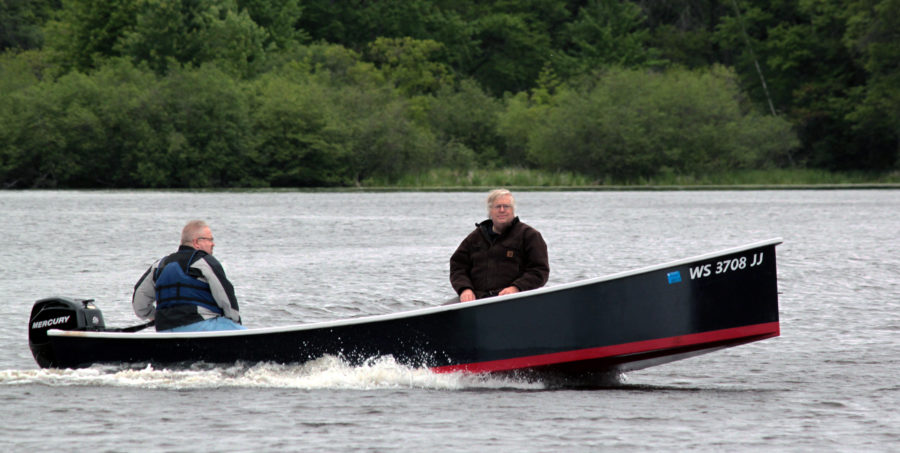
Boat Profile
I’ve had a copy of Phil Bolger’s book Boats With An Open Mind for a long time, and I’ve always liked the looks of the Clam Skiff he designed for…
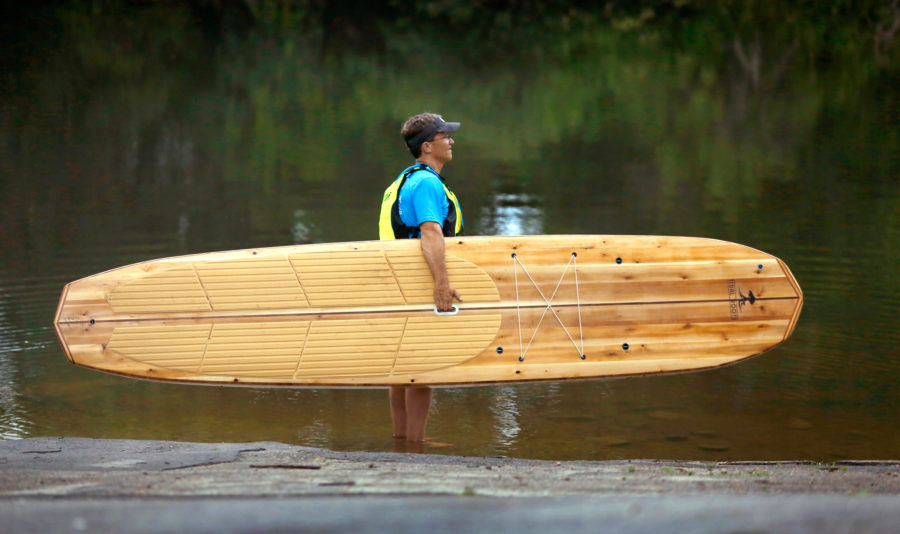
The Sand Bar by Tidal Roots
I was paddling on a placid Royal River with my four-year-old son Noah kneeling in front of me on a wooden Tidal Roots stand-up-paddle (SUP) board. The water hissed quietly…
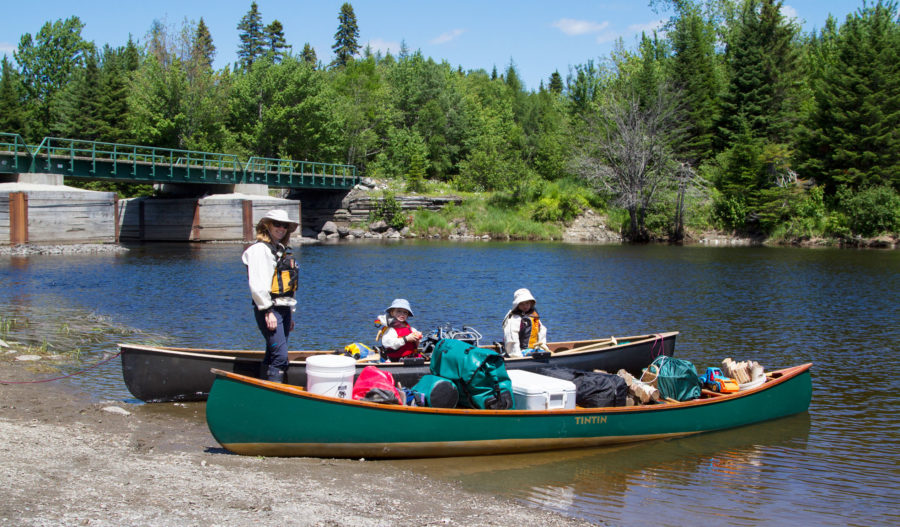
Investing in Memories
“Come TINTIN, come,” my four-year-old daughter hollered, then broke into a giggle. Her two-year-old brother threw back his head and let rip with his best belly laugh. We paddled, a…
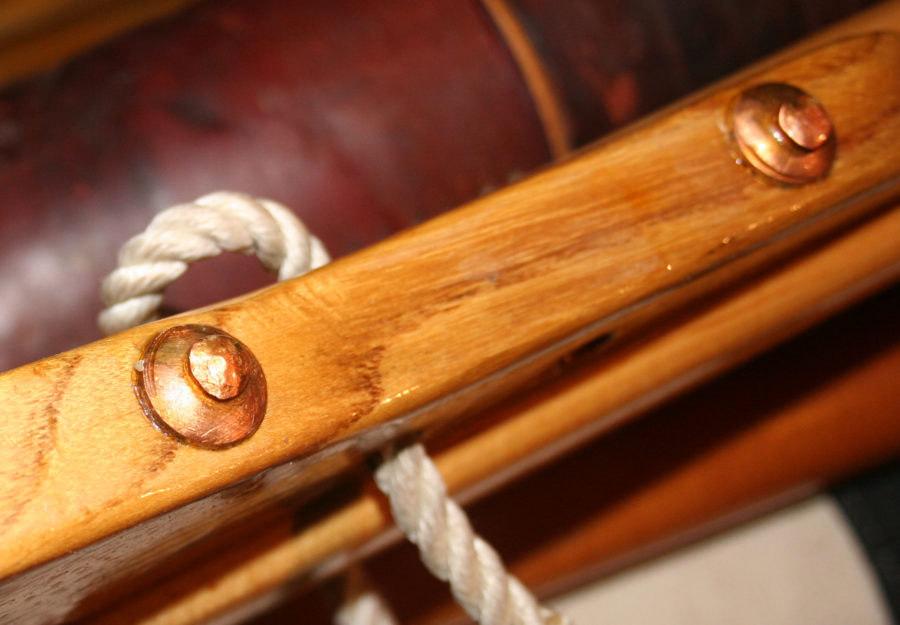
Homemade Rivets and Roves
I recently needed a handful of long rivets to secure the sides of a centerboard trunk to its ledges and to fasten jaws to a boom. Even if I could…
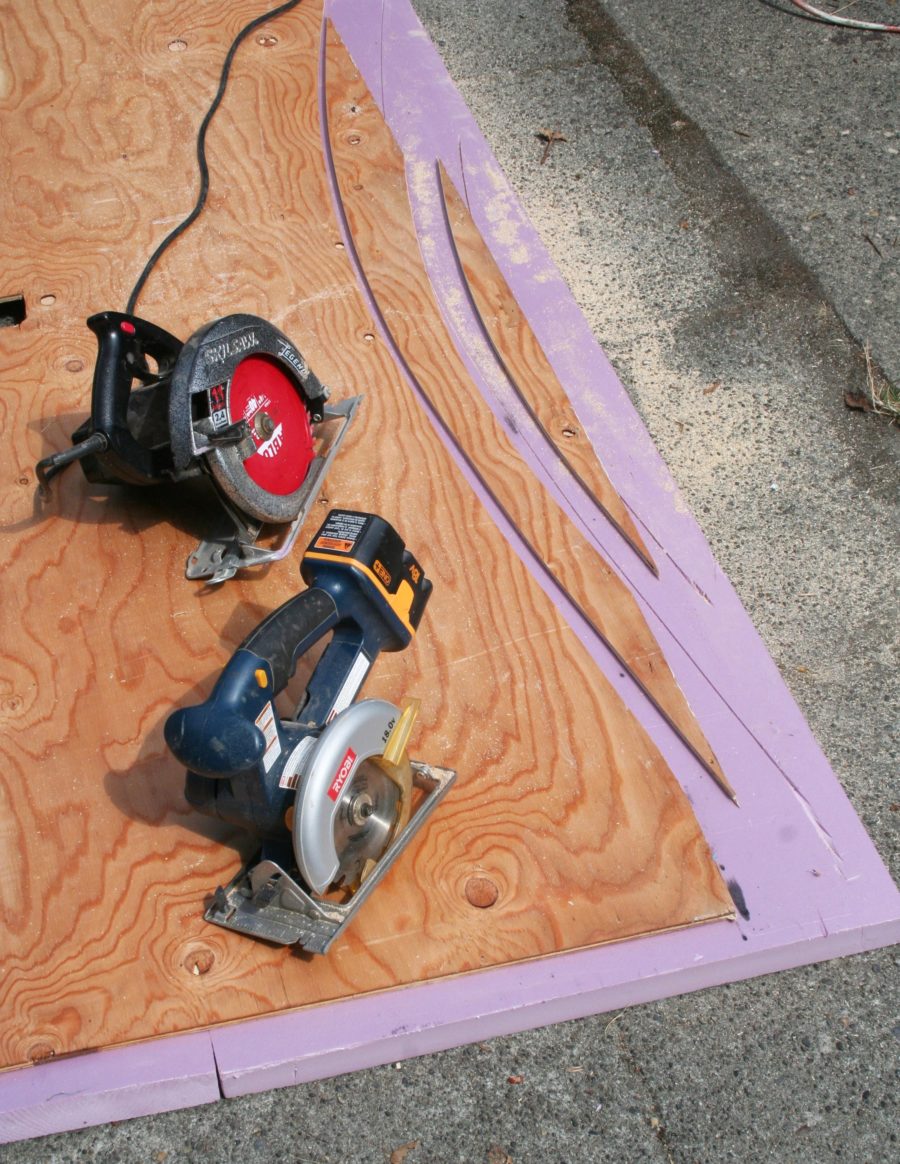
The Taming of the Sheet
Most of us who build boats at home do not have the facilities needed to handle 4′ x 8′ sheets of marine plywood with ease. I’ve always found it challenging…
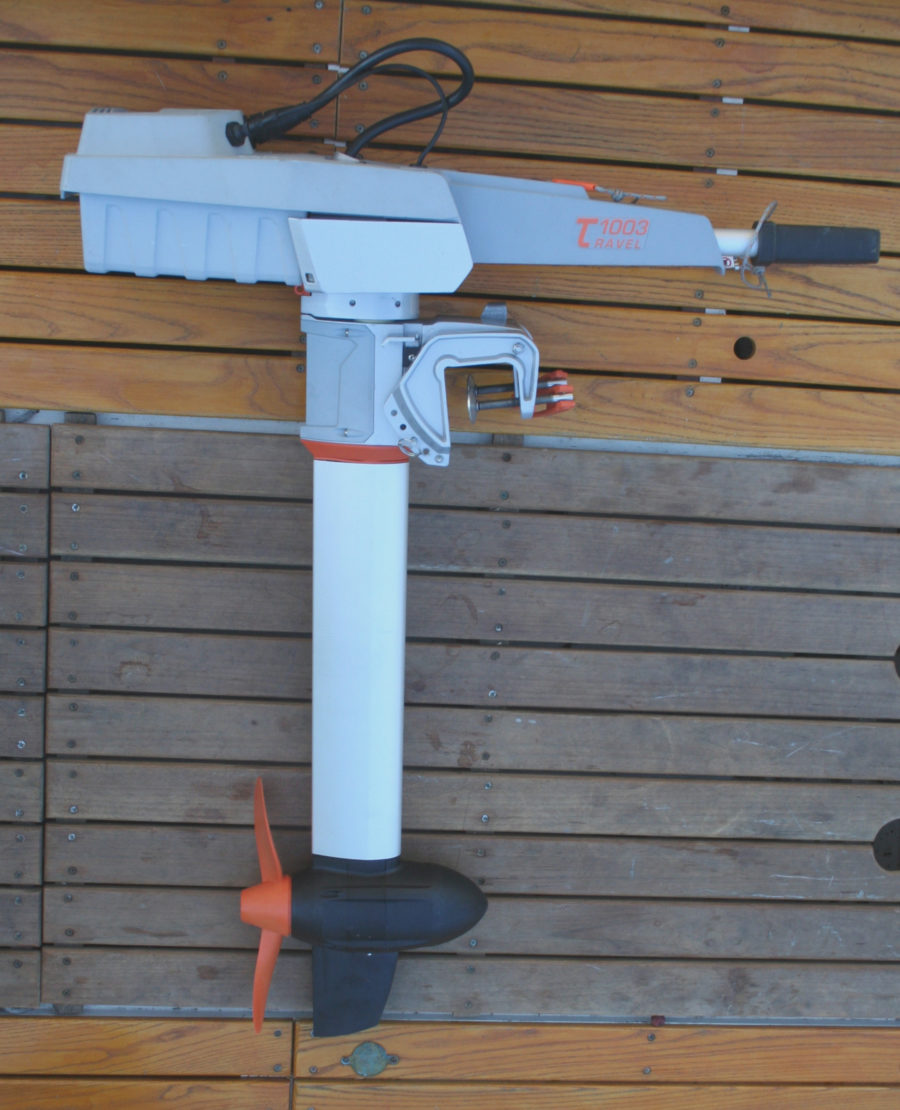
For decades I resisted boating under power and took pride in getting where I wanted to go under my own steam or under sail. That changed when I had kids:…
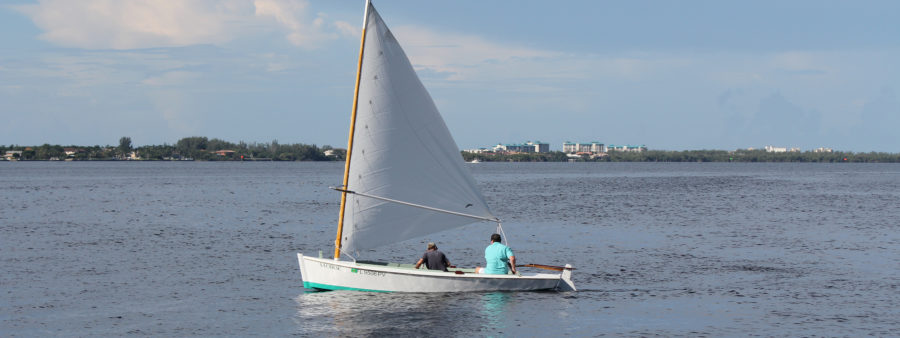
Reader Built Boats
Kevin Moroney grew up in South Salem, New York, not quite 10 miles south-southwest of Danbury, Connecticut; his home was near Truesdale Lake, a finger of water just shy of…
More Product Reviews
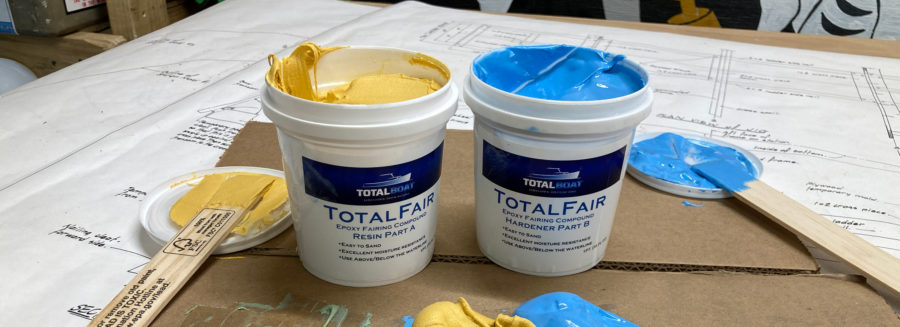
TotalFair is a two-part epoxy-based compound, packaged in separate containers of resin and hardener. The fairing filler is mixed into both parts, so there is no guessing how much filler…
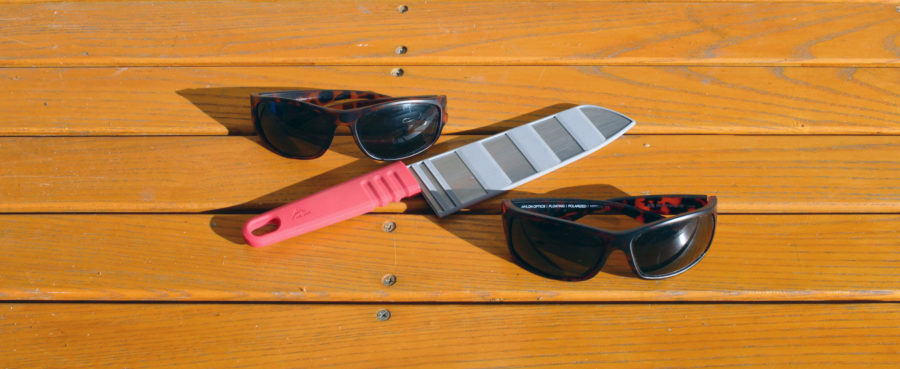
Chef’s Knife and Floating Sunglasses
MSR’s Alpine Chef’s Knife For years, my favorite camp-cooking knife has been a Joyce Chen paring knife with a 3-3/4″ stainless blade and a plastic handle and sheath. It did...
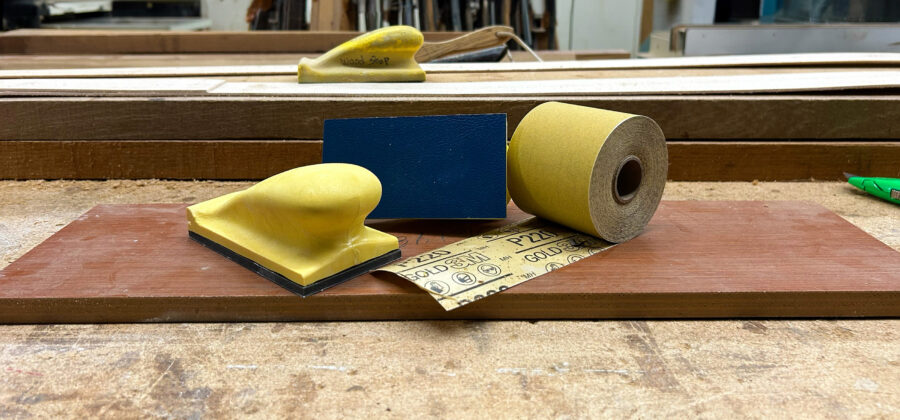
3M Stikit Hand Block
That 3M Stikit Soft Hand Block felt good in my hand. It was flexible and soft enough that I could sense the surface below, and it molded to the curves…
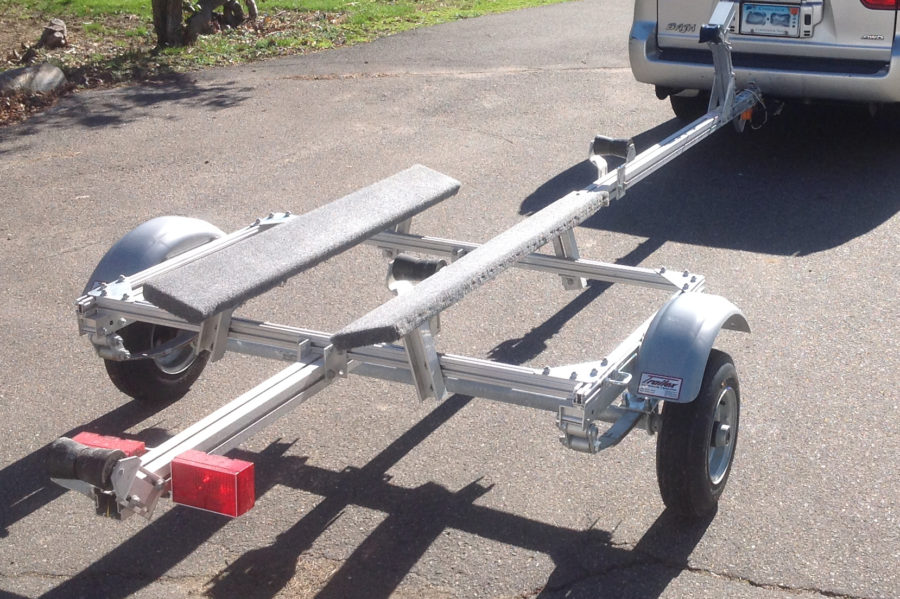
Trailex SUT-350-S
I have a small-boat business with an emphasis on tradition-based rowboats and rowing accessories and I usually do the fitting-out of hardware at my shop, often requiring that I pick…
Subscribe Today!
Become a subscriber today and you’ll recieve a new issue every month plus unlimited access to our full archive of backlogged issues.
Already a subscriber? Sign In
Subscribe For Full Access
Flipbooks are available to paid subscribers only. Subscribe now or log in for access.
- ‹ Return |
- › Products
- › Travel 1103
- › Travel 1103 C
JavaScript functionality for your browser has been deactivate. Please activate JavaScript so you can use all functions on this page.
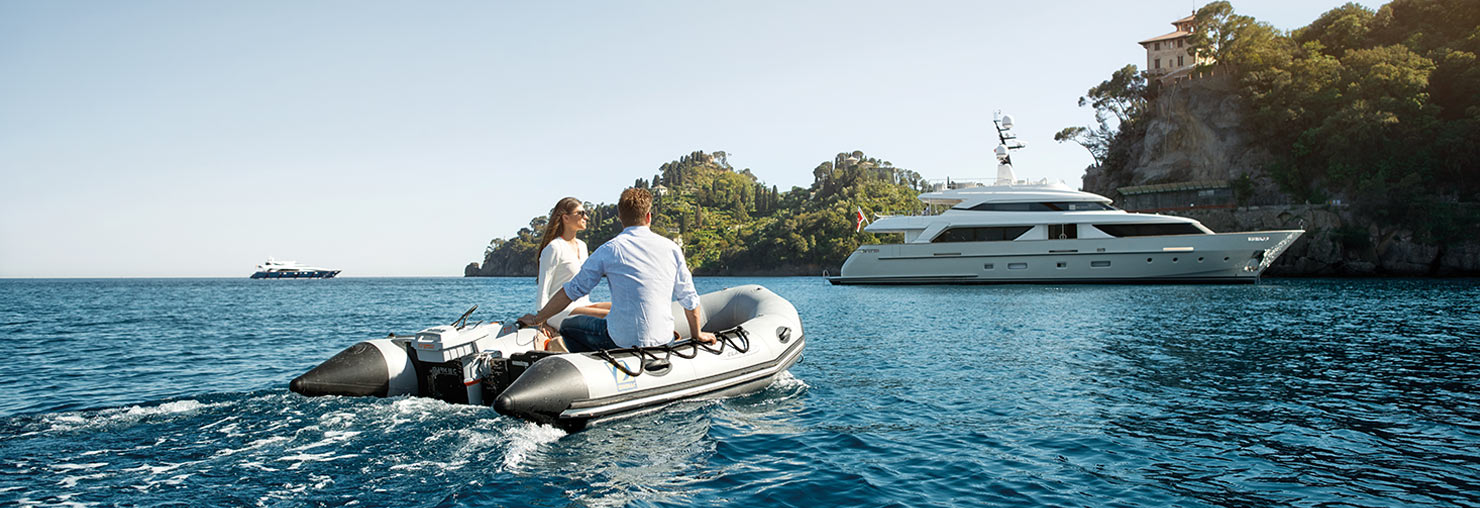
The 1103 C model is the top-of-the-line model of our globally successful Travel series. Featuring a direct-drive motor design, it comes with the high-capacity 915 Wh battery – a range-extending 73% increase in capacity compared to the base model. The 1103 C delivers 1,100 W, a strong aluminium pylon for increased protection from impact damage and an upgraded transom mount.
Travel 1103 – Benefits:
- With its integrated lithium battery and its outstanding efficiency, the Travel is the alternative to a small petrol outboard
- Can do everything that a 3 HP petrol outboard can, plus it’s environmentally friendlier, quieter, lighter and more convenient
- Completely waterproof (IP67)
- Instantaneous throttle response
- On-board computer with GPS-based calculation of remaining range
- Solar rechargeable – including during the voyage
- Can be easily dismantled for transport and space-saving storage; the outboard on its own weighs only 11.3 kg (S) / 11.7 kg (L)
- A clean affair: no matter how or where you store your Travel – there’s no risk of leakage or petrol smells
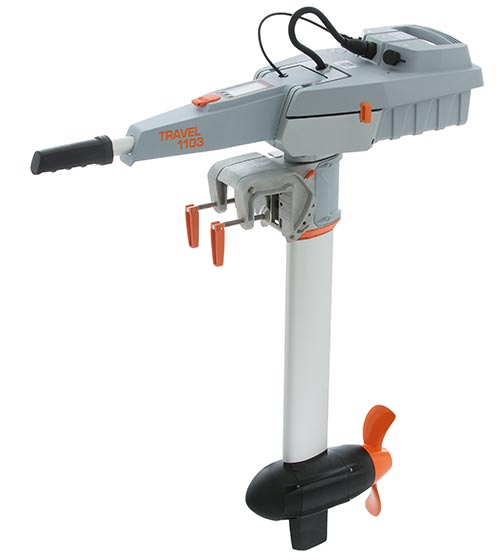

COMMENTS
Travel 1003 Operating Instructions - French / Italian. Travel 1003 Operating Instructions - Spanish / Portuguese. Travel 1003 Operating Instructions - Swedish / Finnish. Travel 1003 Operating Instructions - Dutch / Danish. Charger Travel 1003 Operating Instructions. Tiller Extension Travel 1003.
View and Download Torqeedo Travel 1003 S operating instructions manual online. Travel 1003 S outboard motor pdf manual download. Also for: Travel 503, Travel 1003l, Travel 1003, Travel 1103 cs, Travel 1103 cl. ... Sie den Akku vor dem ersten Gebrauch oder nach mehrmonatiger Lage- rung zu 100 % auf, um die Ladezustandsanzeige zu kalibrieren.
This is where you can find operating instructions for all Torqeedo products. Dealer Login; Account. Log in New Account Language North America ... Travel 503 / 603 / 1003 / 1103 C - Operating Instructions ; Travel 503 / 603 / 1003 / 1103 C - German / English: Travel 503 / 603 / 1003 / 1103 C - French / Italian:
Travel 1003 - Torqeedo. The Travel 1003 delivers over 1,000 watts of input power and in terms of propulsion is comparable with 3 HP petrol outboard. Its name says it all. With the Travel 1003 you can discover the world on water, completely waterproof to IP67. Thanks to the on-board computer with its GPS-based calculation of the remaining range ...
The Torqeedo Travel 1003 S is an outboard motor designed for boating enthusiasts seeking a reliable and efficient propulsion system. Manufactured by Torqeedo, a leading provider of electric and solar-powered marine propulsion systems, the Travel 1003 S offers a range of features and benefits. With its lightweight design and powerful lithium ...
We have 2 Torqeedo Travel 1003 manuals available for free PDF download: Operating Instructions Manual, Operating Manual Torqeedo Travel 1003 Operating Instructions Manual (112 pages) Brand: Torqeedo | Category: Outboard Motor | Size: 1.1 MB
Torqeedo
4.2 Konformitätserklärung Für die nachfolgend bezeichneten Erzeugnisse 1140-00 - Travel 503 S 1142-00 - Travel 1003 S 1141-00 - Travel 503 L 1143-00 - Travel 1003 L wird hiermit erklärt, dass sie den wesentlichen Schutzanforderungen entsprechen, die in den nachfolgend bezeichneten Richtlinien festgelegt sind: • RICHTLINIE 2014/30/EU DES ...
Name of model Travel 503 S Travel 503 L Travel 1003 S Travel 1003 L Max. input power (in Watt) 500 500 1.000 1.000 Max. propulsive power (in Watt) 220 220 480 480 Max. overall efficiency (in %) 44 44 48 48 Comparable petrol outboard motor (propulsive power) 1.5 HP 1.5 HP 3 HP 3 HP Proper use for boats with total weight to (in tonnes) 0.8 0.8 1. ...
Torqeedo Travel Motoren. Bitte beachten Sie neben diesen Hinweisen die gesamte Bedie- ... • Die Travel 503/1003 Modelle sind nach Schutzart IP67 gegen Schmutz- und Wasserein- ... zu kalibrieren (99% Ladung ist für die Kalibrierung nicht ausreichend).
Torqeedo tips and tricks to fix problems and make your torqeedo trouble free.
The Travel 503 is rated as the equivalent of a 1.5-hp gas motor; the Travel 1003, the equivalent of a 3-hp. I tried the Travel 1003S (S for short shaft) on three different boats: the Caledonia yawl, a Whitehall, and an Escargot canal boat. Torqeedo lists the shaft length for the Travel 1003S at 62.5 cm (24 5/8″), a measurement from the ...
Error codes 21, 22 and 23 mean that you need to recalibrate the throttle on your Torqeedo Travel Motor. It often occurs when you install a tiller extension. ...
Typenbezeichnung Travel 503 S/L Travel 1003 S/L Travel 1003 CS/CL Max. Eingangsleistung (in Watt) 500 1.000 1.000 Max. Vortriebsleistung (in Watt) 220 480 480 Max. Gesamtwirkungsgrad (in %) 44 48 48 Vergleichbarer Benzin-Außenborder (Vortriebsleistung) 1,5 PS 3 PS 3 PS Bestimmungsgemäßer Gebrauch für Boote mit Gesamtgewicht bis (in Tonnen ...
This video helps you understand what error code 45 (E 45) on your Torqeedo Travel motor means, and what you can do to clear it.
Travel 503 / 603 / 1003 / 1103 C - Operating Instructions. Travel 503 / 603 / 1003 / 1103 C - German / English Travel 503 / 603 / 1003 / 1103 C - French / Italian ... ©2024 Torqeedo Inc. Products. Outboards › Ultralight › Travel › Cruise › Deep Blue; Inboards; Pod Drives; Deep Blue Hybrid; Sail Drives; Batteries; Customer Service ...
When comparing these prices with other travel packages, you get the impression that it is hardly worthwhile travelling individually on the Trans-Siberian Railway. Please keep in mind that most packages last no more than 14 days and you are herded like cattle through the most beautiful locations.
In addition to our standard services, Grand Russia offers tours packages to Moscow and St Petersburg. You cannot resist our Two Hearts of Russia (7 Days &6 Nights), Golden Moscow (4 Days &3 Nights), Sochi (3 Days & 2 Nights), Golden Ring (1 Day & 2 Days), and many more. As a leading travel agency specializing in the tour to Russia and Former ...
Information provided by IMLS is deemed reliable but not guaranteed. 1003 E 7th St, Moscow, ID 83843 is currently not for sale. The 1,350 Square Feet single family home is a 3 beds, 2 baths property. This home was built in 1958 and last sold on -- for $--. View more property details, sales history, and Zestimate data on Zillow.
The Torqeedo Travel's on-board computer calculates the remaining range constantly, by linking the motor's consumption data with the charging level of the batteries, and the speed over the ground from the GPS. This allows you to read the remaining range in real time from the motor display or the smartphone app TorqTrac. This website uses cookies.
1003 Victoria Court. Great entry-level home or downsizer located in Eastman Acres subdivision just 5 miles outside of Moscow. Property includes a level, usable lot with a fenced backyard and a huge deck and pergola for relaxing. Tons of storage or space for hobbies with a 2-car attached garage AND a separate 24 x 24 shop!
Travel 1003; Input power in watts: 1000: Propulsive power in watts: 480: Comparable petrol outboards (propulsive power) 3 HP: ... To compare Torqeedo static thrust data with conventional trolling motors, add approximately 50% to the Torqeedo static thrust values. Technical Drawing . Travel 1003L Travel 1003S . This website uses cookies. By ...
The 1103 C model is the top-of-the-line model of our globally successful Travel series. Featuring a direct-drive motor design, it comes with the high-capacity 915 Wh battery - a range-extending 73% increase in capacity compared to the base model. The 1103 C delivers 1,100 W, a strong aluminium pylon for increased protection from impact damage ...